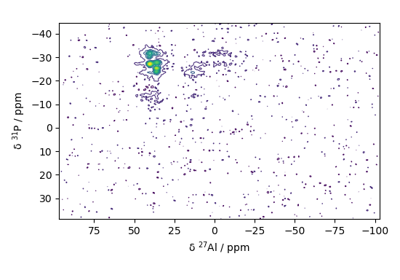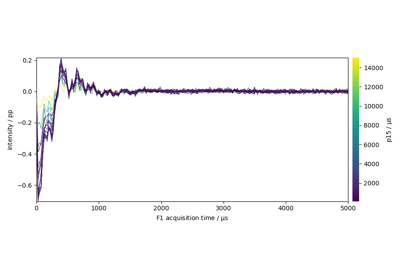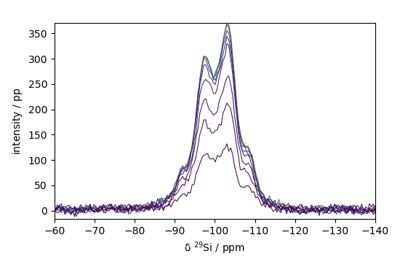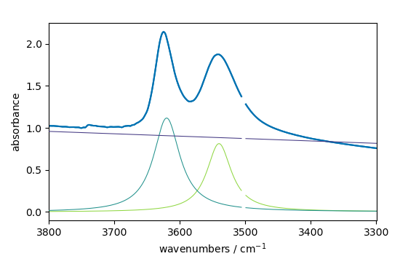spectrochempy.Optimize¶
- class Optimize(*, log_level='WARNING', warm_start=False, amplitude_mode='height', autoampl=False, autobase=False, callback_every=10, constraints=None, dry=False, max_fun_calls=0, max_iter=500, method='least_squares', script='')[source]¶
Non-linear Least-Square Optimization and Curve-Fitting.
Works on a 1D or 2D dataset.
# TODO: complete this description
- Parameters
log_level (any of [
"INFO","DEBUG","WARNING","ERROR"], optional, default:"WARNING") – The log level at startup. It can be changed later on using theset_log_levelmethod or by changing thelog_levelattribute.warm_start (
bool, optional, default:False) – When fitting repeatedly on the same dataset, but for multiple parameter values (such as to find the value maximizing performance), it may be possible to reuse previous model learned from the previous parameter value, saving time.When
warm_startisTrue, the existing fitted model attributes is used to initialize the new model in a subsequent call tofit.amplitude_mode (any value of [
'area','height'], optional, default:'height') – Initial amplitude setting mode.autoampl (
bool, optional, default: False) – Whether to apply an automatic amplitude correction.autobase (
bool, optional, default: False) – Whether to apply an automatic baseline correction.callback_every (
int, optional, default: 10) – Number of iteration between each callback report. Used for printing or display intermediate results.constraints (any value, optional, default:
None) – Constraints.dry (
bool, optional, default: False) – If True perform a dry run. Mainly used to check the validity of the input parameters.max_fun_calls (
int, optional, default: 0) – Maximum number of function calls at each iteration.max_iter (
int, optional, default: 500) – Maximum number of fitting iteration.method (any value of [
'least_squares','leastsq','simplex','basinhopping'], optional, default:'least_squares') – Optimization method (see scipy.optimize docs for details).script (
str, optional, default:'') – Script defining models and parameters for fitting.
Attributes Summary
Return the X input dataset (eventually modified by the model).
The
Yinput.Initial amplitude setting mode.
Whether to apply an automatic amplitude correction.
Whether to apply an automatic baseline correction.
Number of iteration between each callback report.
NDDatasetwith components in feature space (n_components, n_features).traitlets.config.Configobject.Constraints.
If True perform a dry run.
A trait whose value must be an instance of a specified class.
Return
logoutput.Maximum number of function calls at each iteration.
Maximum number of fitting iteration.
Optimization method (see scipy.optimize docs for details).
An instance of a Python list.
Number of components that were fitted.
Object name
Script defining models and parameters for fitting.
User defined models.
Methods Summary
fit(X)Perform a non-linear optimization of the
Xdataset.fit_transform(X[, Y])Fit the model with
Xand apply the dimensionality reduction onX.get_components([n_components])Return the component's dataset: (selected n_components, n_features).
inverse_transform([X_transform])Transform data back to its original space.
parameters([replace, removed, default])Alias for
paramsmethod.params([default])Current or default configuration values.
plotmerit([X, X_hat])Plot the input (
X), reconstructed (X_hat) and residuals.predict()Return the fitted model.
reconstruct([X_transform])Transform data back to its original space.
reduce([X])Apply dimensionality reduction to
X.reset()Reset configuration parameters to their default values
to_dict()Return config value in a dict form.
transform([X])Apply dimensionality reduction to
X.Attributes Documentation
- X¶
Return the X input dataset (eventually modified by the model).
- amplitude_mode¶
Initial amplitude setting mode.
- autoampl¶
Whether to apply an automatic amplitude correction.
- autobase¶
Whether to apply an automatic baseline correction.
- callback_every¶
Number of iteration between each callback report. Used for printing or display intermediate results.
- components¶
NDDatasetwith components in feature space (n_components, n_features).See also
get_componentsRetrieve only the specified number of components.
- config¶
traitlets.config.Configobject.
- constraints¶
Constraints.
- dry¶
If True perform a dry run. Mainly used to check the validity of the input parameters.
- fp¶
A trait whose value must be an instance of a specified class.
The value can also be an instance of a subclass of the specified class.
Subclasses can declare default classes by overriding the klass attribute
- log¶
Return
logoutput.
- max_fun_calls¶
Maximum number of function calls at each iteration.
- max_iter¶
Maximum number of fitting iteration.
- method¶
Optimization method (see scipy.optimize docs for details).
- modeldata¶
An instance of a Python list.
- n_components¶
Number of components that were fitted.
- name¶
Object name
- script¶
Script defining models and parameters for fitting.
- usermodels¶
User defined models.
Methods Documentation
- fit(X)[source]¶
Perform a non-linear optimization of the
Xdataset.- Parameters
X (
NDDatasetor array-like of shape (n_observations, n_features)) – Training data.- Returns
self – The fitted instance itself.
See also
fit_transformFit the model with an input dataset
Xand apply the dimensionality reduction onX.fit_reduceAlias of
fit_transform(Deprecated).
- fit_transform(X, Y=None, **kwargs)[source]¶
Fit the model with
Xand apply the dimensionality reduction onX.- Parameters
X (
NDDatasetor array-like of shape (n_observations, n_features)) – Training data.Y (any) – Depends on the model.
**kwargs (keyword parameters, optional) – See Other Parameters.
- Returns
NDDataset– Dataset with shape (n_observations, n_components).- Other Parameters
n_components (
int, optional) – The number of components to use for the reduction. If not given the number of components is eventually the one specified or determined in thefitprocess.
- get_components(n_components=None)¶
Return the component’s dataset: (selected n_components, n_features).
- Parameters
n_components (
int, optional, default:None) – The number of components to keep in the output dataset. IfNone, all calculated components are returned.- Returns
NDDataset– Dataset with shape (n_components, n_features)
- inverse_transform(X_transform=None, **kwargs)¶
Transform data back to its original space.
In other words, return an input
X_originalwhose reduce/transform would beX_transform.- Parameters
X_transform (array-like of shape (n_observations, n_components), optional) – Reduced
Xdata, wheren_observationsis the number of observations andn_componentsis the number of components. IfX_transformis not provided, a transform ofXprovided infitis performed first.**kwargs (keyword parameters, optional) – See Other Parameters.
- Returns
NDDataset– Dataset with shape (n_observations, n_features).- Other Parameters
n_components (
int, optional) – The number of components to use for the reduction. If not given the number of components is eventually the one specified or determined in thefitprocess.
See also
reconstructAlias of inverse_transform (Deprecated).
- parameters(replace="params", removed="0.7.1") def parameters(self, default=False)[source]¶
Alias for
paramsmethod.
- plotmerit(X=None, X_hat=None, **kwargs)[source]¶
Plot the input (
X), reconstructed (X_hat) and residuals.\(X\) and \(\hat{X}\) can be passed as arguments. If not, the
Xattribute is used for \(X\)and \(\hat{X}\)is computed by theinverse_transformmethod- Parameters
X (
NDDataset, optional) – Original dataset. If is not provided (default), theXattribute is used and X_hat is computed usinginverse_transform.X_hat (
NDDataset, optional) – Inverse transformed dataset. ifXis provided,X_hatmust also be provided as compuyed externally.**kwargs (keyword parameters, optional) – See Other Parameters.
- Returns
Axes– Matplotlib subplot axe.- Other Parameters
colors (
tupleorndarrayof 3 colors, optional) – Colors forX,X_hatand residualsE. in the case of 2D, The default colormap is used forX. By default, the three colors areNBlue,NGreenandNRed(which are colorblind friendly).offset (
float, optional, default:None) – Specify the separation (in percent) between the \(X\) , \(X_hat\) and \(E\).nb_traces (
intor'all', optional) – Number of lines to display. Default is'all'.**others (Other keywords parameters) – Parameters passed to the internal
plotmethod of theXdataset.
- reconstruct(X_transform=None, **kwargs)[source]¶
Transform data back to its original space.
In other words, return an input
X_originalwhose reduce/transform would beX_transform.- Parameters
X_transform (array-like of shape (n_observations, n_components), optional) – Reduced
Xdata, wheren_observationsis the number of observations andn_componentsis the number of components. IfX_transformis not provided, a transform ofXprovided infitis performed first.**kwargs (keyword parameters, optional) – See Other Parameters.
- Returns
NDDataset– Dataset with shape (n_observations, n_features).- Other Parameters
n_components (
int, optional) – The number of components to use for the reduction. If not given the number of components is eventually the one specified or determined in thefitprocess.
See also
reconstructAlias of inverse_transform (Deprecated).
Notes
Deprecated in version 0.6.
- reduce(X=None, **kwargs)[source]¶
Apply dimensionality reduction to
X.- Parameters
X (
NDDatasetor array-like of shape (n_observations, n_features), optional) – New data, where n_observations is the number of observations and n_features is the number of features. if not provided, the input dataset of thefitmethod will be used.**kwargs (keyword parameters, optional) – See Other Parameters.
- Returns
NDDataset– Dataset with shape (n_observations, n_components).- Other Parameters
n_components (
int, optional) – The number of components to use for the reduction. If not given the number of components is eventually the one specified or determined in thefitprocess.
Notes
Deprecated in version 0.6.
- transform(X=None, **kwargs)¶
Apply dimensionality reduction to
X.- Parameters
X (
NDDatasetor array-like of shape (n_observations, n_features), optional) – New data, where n_observations is the number of observations and n_features is the number of features. if not provided, the input dataset of thefitmethod will be used.**kwargs (keyword parameters, optional) – See Other Parameters.
- Returns
NDDataset– Dataset with shape (n_observations, n_components).- Other Parameters
n_components (
int, optional) – The number of components to use for the reduction. If not given the number of components is eventually the one specified or determined in thefitprocess.
Examples using spectrochempy.Optimize

Processing NMR spectra (slicing, baseline correction, peak picking, peak fitting)


